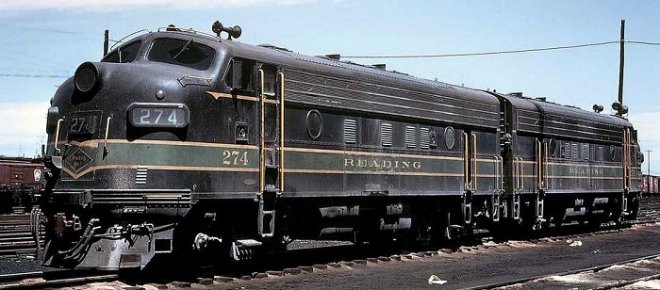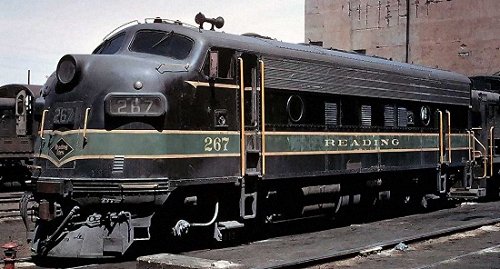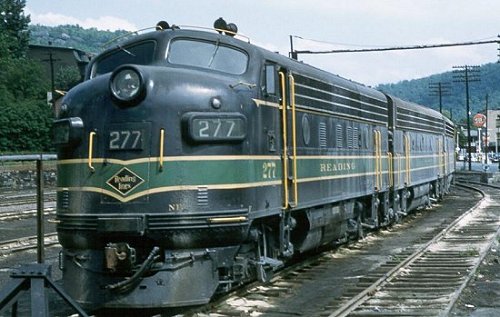EMD: F7

The Reading's final diesel freight cab units were the 24 F7 locomotives in class DF-4. The class was split between 6 locomotives coupled as A-B units numbered 266 A/B to 271 A/B, and an additional 12 A units numbered 272A through 283A. The F7s were one of EMD's most popular locomotives, with over 3600 units being constructed for most American railroads. While the original FT may have been the "diesel that did it," it was the F7 that put steam power to rest on many railroads, including the Reading. The road's F7 units arrived throughout 1950, and were nearly identical in appearance to the earlier F3s. The main spotting difference was the addition of a raised dynamic brake fan on the roof behind the cab, where the F3 had a vent flush with the roofline. This gave the F7 five visible rooftop fans instead of the F3's four.
 Upon entry into service, 18 F7 locomotives were assigned to the Shamokin Division, hauling freight on the Catawissa and Mahanoy & Shamokin Branches. The visibility afforded by the high, wide windows was a benefit to crews operating on these lines due to the many curves and grades encountered. Having learned a lesson from the problems experienced by operating the earlier F3s in ABBA configuration, the Reading operated its F7s in 3-unit ABA sets. The greater weight and increased sand capacity of the F7s allowed the Reading to increase the tonnage ratings for trains on these lines. The remaining F7s were operated from Gordon and Rutherford to Port Reading, NJ. The locomotives were also occasionally used on crossline trains between Rutherford and Allentown.
Upon entry into service, 18 F7 locomotives were assigned to the Shamokin Division, hauling freight on the Catawissa and Mahanoy & Shamokin Branches. The visibility afforded by the high, wide windows was a benefit to crews operating on these lines due to the many curves and grades encountered. Having learned a lesson from the problems experienced by operating the earlier F3s in ABBA configuration, the Reading operated its F7s in 3-unit ABA sets. The greater weight and increased sand capacity of the F7s allowed the Reading to increase the tonnage ratings for trains on these lines. The remaining F7s were operated from Gordon and Rutherford to Port Reading, NJ. The locomotives were also occasionally used on crossline trains between Rutherford and Allentown.
 As occurred with the F3s, the arrival of the F7s allowed the Reading to demote or retire some steam power, in this case 17 K-1 2-10-2 locomotives that were reassigned from the Reading Division to the Shamokin Division. The road's growing reliance on diesel power for mainline freight operation accelerated the end of steam power on the Reading, with the road being completely dieselized by 1956. However, while many railroads kept their cab units for quite some time, the Reading's progressive attitude toward motive power technology also led to the end of the F7s, as they were traded in to EMD in 1964 towards the purchase of additional GP35s.
As occurred with the F3s, the arrival of the F7s allowed the Reading to demote or retire some steam power, in this case 17 K-1 2-10-2 locomotives that were reassigned from the Reading Division to the Shamokin Division. The road's growing reliance on diesel power for mainline freight operation accelerated the end of steam power on the Reading, with the road being completely dieselized by 1956. However, while many railroads kept their cab units for quite some time, the Reading's progressive attitude toward motive power technology also led to the end of the F7s, as they were traded in to EMD in 1964 towards the purchase of additional GP35s.
Did You Know?
Downloads
 A variety of Reading Company operations related documents, etc. that may be of use in your modeling efforts.
A variety of Reading Company operations related documents, etc. that may be of use in your modeling efforts.
 A variety of Reading Company operations paperwork, such as train orders, clearance forms, etc. that will help you operate your Reading layout in a prototypical manner.
A variety of Reading Company operations paperwork, such as train orders, clearance forms, etc. that will help you operate your Reading layout in a prototypical manner.
 Public Timetables, Employe Timetables, and Rulebooks that provide much useful operational information.
Public Timetables, Employe Timetables, and Rulebooks that provide much useful operational information.
 Signs, billboards, and other FREE goodies for your use. We ask only that you help spread the word about The Reading Modeler!
Signs, billboards, and other FREE goodies for your use. We ask only that you help spread the word about The Reading Modeler!

